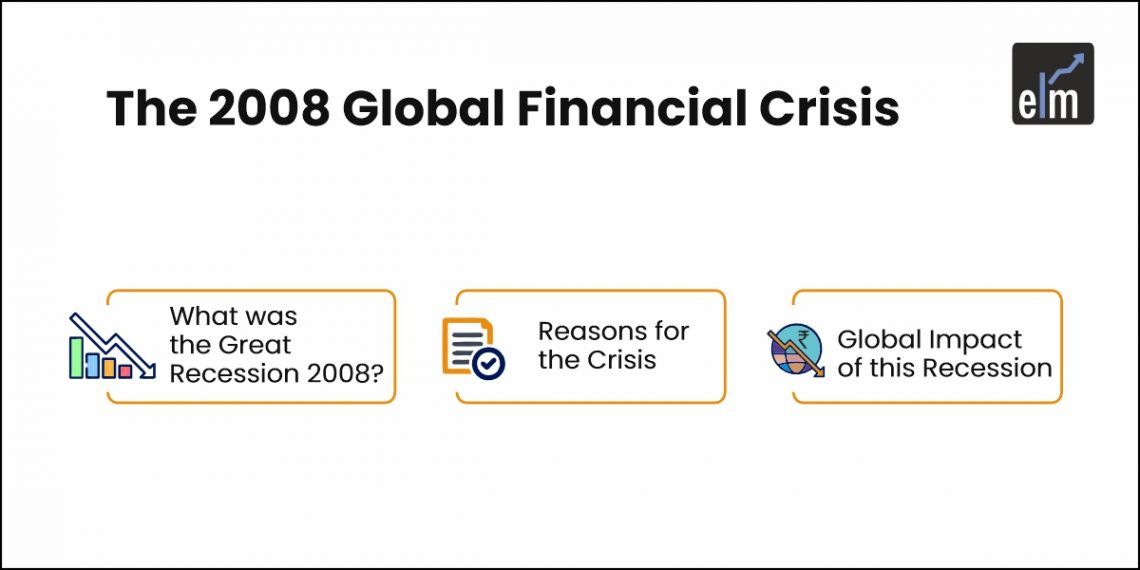Are you Scared of the markets Falling right Now?
Do you think that this is a Recession?
Do you feel this is the time to stay away from the market?
Well, do not let the falsly created ghost of 2024 haunt you. We are going to discuss an era that still haunts the dreams of various big financial brains!
THE DARK YEAR OF 2008 Global Financial Crisis,
A year when the most Brilliant financial minds were on the road, Giant banks were hanging on the edge to survive, and the global markets were watching helplessly!
- Nearly 9 million jobs were lost during 2008 and 2009, causing the unemployment rate to double!
- Housing prices dropped by almost 30%, and real estate took a long time to recover.
- The U.S. stock market saw a sharp decline of about 50% by early 2009.
- The amount of US household wealth that fell was 13 trillion dollars, a 20% drop from its pre-crisis high.
Scaring Data, right?
This was due to the SubPrime Crisis or The Great Recession!
Why did this happen? What went wrong? And How bad was it?
Let’s understand in Detail!
What Was The 2008 Global Financial Crisis?
With the interest Rates increasing and the SubPrime Loans rigged, the housing sector fell drastically.
When this Bubble burst, many borrowers were unable to pay their loans, leading to a sharp rise in foreclosures.
Several financial institutions and merchant banks, such as Lehman Brothers, Morgan Stanley, and JP Morgan, failed, and many needed government bailouts.
Along with the housing market crash, the stock market also took a significant hit, with the Dow Jones Industrial Average losing more than half its value.
The crisis spread globally and became the main trigger for the global financial crisis.
The Start of the Great Recession!
Interest rates during 2001 were lowered from 6.5% to 1% due to the dot-com bubble burst and the Sept. 11, 2001 terrorist attacks.
Low interest rates provided cheap credit, and more people borrowed money to purchase homes.
People were scared of Dot.com companies, so they started moving away from the share market and found real estate as a source of investment.
This made the housing sector the best and most accessible form of Investment.
The Role of Investment Banks and CDOs
With the rising opportunities in the housing sector, everyone jumped in to grab some profit.
While traditional banks provide services like savings, loans, and deposits, investment banks like Goldman operate differently. They focus on raising capital for companies and selling complex financial products.
In the 2000s, these investment banks saw an opportunity in the booming housing market.
They started buying housing loans from regular banks and packaging them into complex financial products called Collateralized Debt Obligations (CDOs).
These CDOs were bundles of home loans that investment banks sold to investors as profitable, safe investments.
They even received AAA ratings—the highest level of safety—from credit rating agencies like Moodys, which attracted more buyers.
So, the Problem with Subprime Loans?
At first, banks were lending to people with good credit histories.
However, as the demand for CDOs grew, banks started giving out risky loans—known as subprime loans—to borrowers with poor credit scores and unstable incomes.
In their rush for commissions and profits, many banks bypassed proper verification, lending to people who were unlikely to repay.
Investment banks bought these subprime loans, bundled them into CDOs, and sold them to investors, who remained confident due to the misleading AAA ratings.
This cycle of risky lending continued, fueling the housing bubble and the ticker bomb for the Great Recession.
The Collapse
Many subprime loans were adjustable-rate mortgages, which started with low interest rates but increased sharply after a few years.
Home prices were rising quickly, so the Federal Reserve, led by Alan Greenspan, raised interest rates multiple times to slow down the overheated market.
Between 2004 and 2006, rates went from 1% to 5.25%, causing many people to default on their loans.
In response, banks started foreclosing homes, flooding the market with properties and pushing home prices down.
As home values dropped, many borrowers faced a tough situation—their loans were now higher than the value of their homes.
Since the credit rating of many borrowers had been ignored, defaults became more frequent.
Eventually, this led to a housing bubble burst.
Impact Of The Great Recession
CDOs crashed because they were filled with bad subprime loans.
Investors lost huge sums of money, and even giants like Lehman Brothers, one of the biggest investment banks in the US went bankrupt.
This also led to a global financial meltdown as these risky instruments had been given around in the world.
To avoid further disaster, the U.S. government had to step in and rescue companies like AIG, which had insured many CDOs through something called Credit Default Swaps (CDS).
AIG suffered losses of a mammoth $99 billion and was rescued by a $85 billion government bailout.
Moody’s, one of the top credit rating agencies, was fined $864m and sued in many other cases for wrongly providing credit ratings under the influence of personal benefits.
The US was losing 800000 jobs every month by then, and a 19% drop in household wealth took place.
Global Impact of the Great Recession
The global economy was also profoundly affected by the crisis. Banks stopped lending, and unemployment soared high.
With the global connection and interdependence of economies, what began in the US spread across the world, leading to a global recession.
Many countries faced financial hardships, and some even declared bankruptcy.
The subprime mortgage crisis dealt a huge blow to the global financial system. Here are some of the effects:
The financial crisis and the global recession that followed wiped out $7.4 trillion from the stock market, while real estate values fell by $3.4 billion, and countless businesses went under.
Around 7.5 million Americans lost their jobs, pushing unemployment from 5% to 10% by 2010. Although jobs eventually returned, many were lower-paying and less secure.
American households saw their net worth shrink by $17 trillion—a 26% drop.
By the time government bailout programs ended in 2014, the Federal Reserve had injected over $4 trillion into the U.S. economy to keep things afloat.
Hope you have got a precise idea of what the 2008 global financial crisis.
So, are you interested in knowing what the Great Depression was??
Stay tuned to our Blogs!







Great knowledge